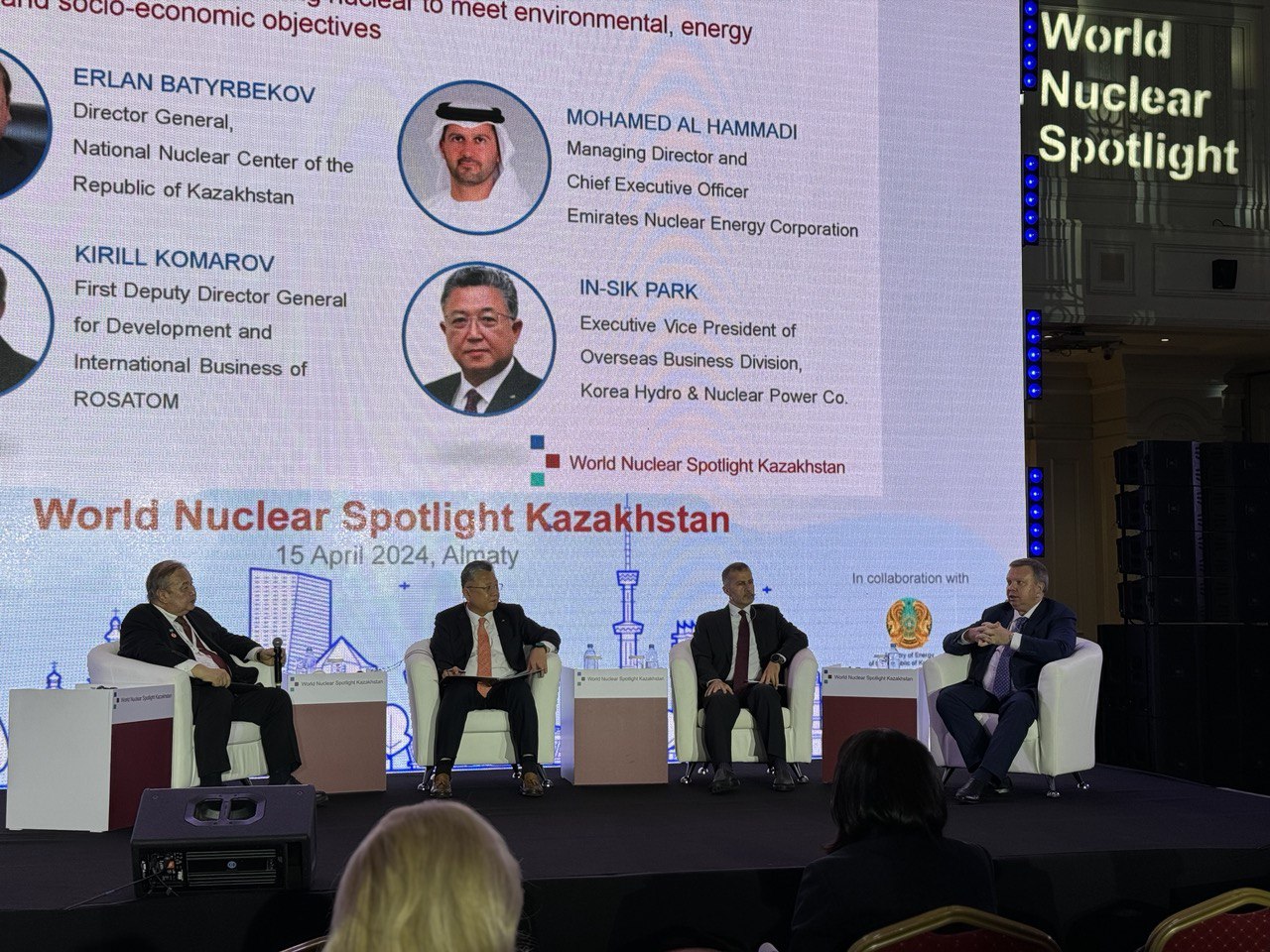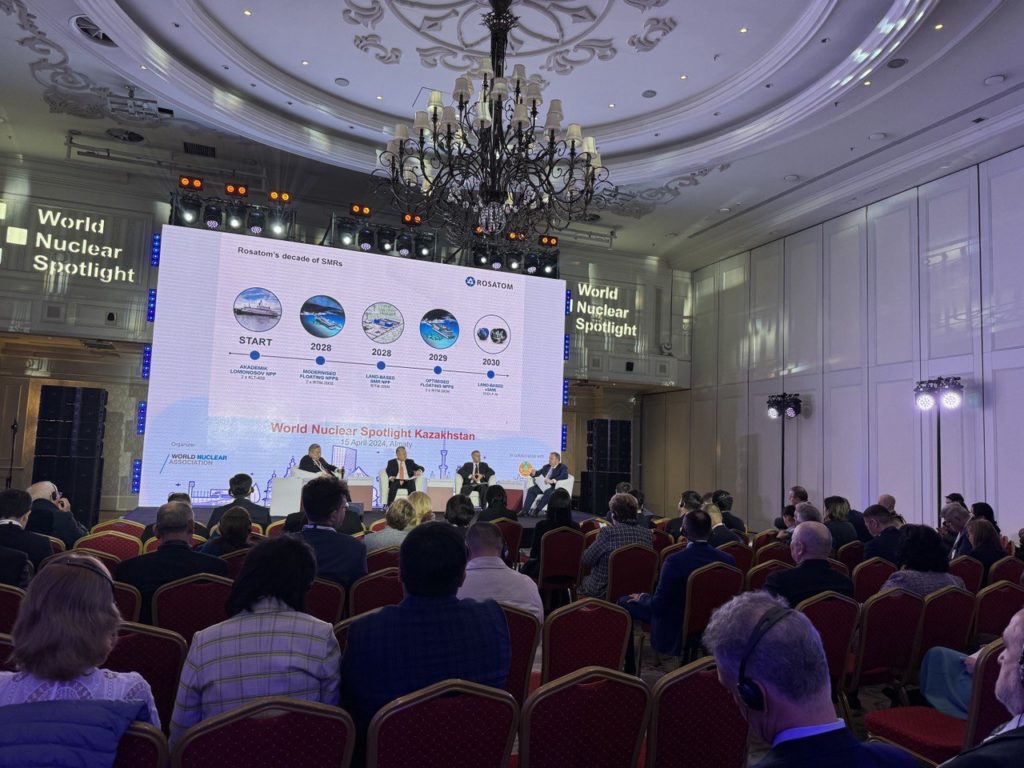
Pathway to Green Energy
back to contentsIn April, Kazakhstan hosted the World Nuclear Spotlight forum organized by the World Nuclear Association and the Kazakhstan Ministry of Energy to discuss the future of nuclear power. Kirill Komarov, First Deputy Director General for Corporate Development and International Business at Rosatom, spoke about the company’s contribution to the global growth of nuclear generation capacity.
Decarbonizing Russian-style
“We are convinced that nuclear power will underlie the low-carbon energy mix worldwide,” Kirill Komarov said. He also noted that the world looking for sustainable energy solutions was turning to nuclear energy as a source of unprecedented opportunities in this field. According to the IAEA estimates, the global nuclear capacity could grow 2.5 times by 2050. To achieve this growth, it would be necessary to overcome the politics-driven division of nuclear power into right and wrong, initiate an open professional discussion, and pursue an integrated approach to nuclear power projects, Kirill Komarov emphasized.
The Russian nuclear corporation is working on increasing nuclear generation, primarily in Russia. As Kirill Komarov noted, Rosatom is Russia’s largest producer of low-carbon electricity, accounting for 20 % of the total electric power generated in the country. Operating 36 power units with an aggregate capacity of 28.5 GW, Russia is among the world’s top five countries in terms of nuclear capacity. By 2045, the share of nuclear in the country’s energy mix is expected to reach 25 % thanks to new nuclear stations in the Urals, Siberia and the Far East. The plan is to build at least 29 power units with a combined capacity of 30 GW in Russia. When the plan is implemented, the total capacity of Russian nuclear power plants will increase one and a half times (taking into account the fact that the operating RBMK reactors will be decommissioned in the 2030s).
Rosatom also makes an immense contribution to the expansion of nuclear capacity around the globe. Out of 25 nuclear power units manufactured for exports worldwide, 22 are being built by the Russian nuclear corporation. “Rosatom has evolved to become an integrated nuclear technology vendor and a global leader in new build. Our technologies and expertise can provide partners around the world with solutions for carbon footprint reduction and sustainable development,” Kirill Komarov expressed his confidence.
Power units with VVER 1200 reactors are the best solution for large-scale nuclear generation projects as they ensure stable operation of the national energy system. These are Generation III+ power units incorporating additional safety systems that minimize the probability of accidents. There are four such units in operation in Russia and two in Belarus, with more under construction in Turkey, Bangladesh, China and Egypt. First concrete will soon be poured for a new VVER 1200 unit in Hungary.
As for small-scale generation, Rosatom was the first in the world to move from words to action and build an advanced floating nuclear power plant, Akademik Lomonosov. It has already generated over 70 TWh of electricity for Russia’s northernmost town of Pevek. The experience gained from it is now used to develop a new line of floating power units with RITM 200 reactors. The first of them are expected to start supplying electric power to the Baimsky GOK mining site in Chukotka as early as 2029. The RITM 200 technology will also be employed to build an onshore small-scale nuclear plant at the Kyuchus gold deposit in Yakutia. “Not every consumer needs 100 MW, so Rosatom offers reactors with a smaller capacity. For instance, a power unit with a 10 MW SHELF-M reactor is being designed for the Sovinoye gold deposit. The experience we are gaining allows us to offer our international partners the best SMR solutions,” Kirill Komarov said.
Fundamentally new reactor technologies are being developed under the umbrella of the Proryv (Breakthrough) Project — it is an experimental nuclear power plant (abbreviated ODEK in Russian) that includes a lead-cooled fast neutron reactor BREST-OD 300, a spent fuel reprocessing unit, and a fuel fabrication/refabrication unit. “Once commissioned, it will make the closed nuclear fuel cycle a reality,” Kirill Komarov is confident. Multiple use of regenerated uranium and plutonium will increase fuel stocks many times over, and the fast neutron spectrum will help dispose of long-lived radioactive isotopes. In the next decade, Rosatom plans to build large-scale power generation facilities based on the Proryv solutions, Kirill Komarov said.
“I would like to emphasize in conclusion that the climate agenda is a special priority for Rosatom. All our solutions make a strong contribution to the efforts of reducing carbon dioxide emissions in Russia and around the world,” Kirill Komarov summarized.
Nuclear energy in Kazakhstan
Kazakhstan, which hosted the WNA conference, has been considering the option of building a nuclear power plant for many years. Atoms are not an unheard-of thing for Kazakhstan. It was there that the world’s first commercial fast neutron reactor BN 350 was put in operation in the 1970s. The reactor is now decommissioned, but the country continues to operate three research reactors. “Nuclear energy is already an essential component of Kazakhstan’s identity,” Vice Minister of Energy Sungat Yesimkhanov told the audience.

The shutdowns of the past few years have shown that Kazakhstan’s energy system is in a difficult situation, and it will only worsen over the years. For this reason, the country’s leadership, business community and ordinary citizens are deeply concerned with finding reliable and sustainable energy solutions. The decision to build a nuclear power plant is planned to be put to a referendum. A site suitable for the nuclear power plant has been found near the village of Ulken on the shores of Lake Balkhash.
Kazakhstan is interested in both large and small-scale nuclear generation. “Kazakhstan’s first nuclear power plant will have a large-capacity reactor. Small modular reactors could be an option to replace retiring coal-fired power plants and provide an ideal solution for some regions,” said Gulmira Mursalova, Deputy Director of the Atomic Energy and Industry Department at Kazakhstan’s Ministry of Energy.
“Kazakhstan is well positioned to take advantage of the benefits that nuclear power offers, and the global nuclear community stands ready to support the country in its efforts,” said WNA Director General Sama Bilbao y León. According to her, the next step of paramount importance is to build a national consensus on nuclear energy. “As soon as Kazakhstan decides to become part of the global nuclear family, we will welcome you,” the WNA chief added.




